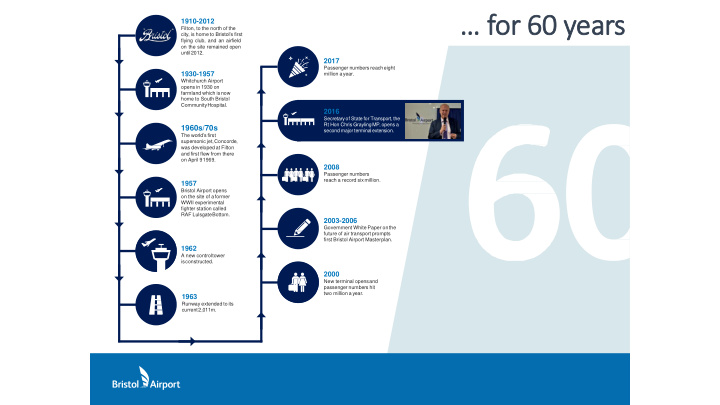



… for 60 years 1910-2012 Filton, to the north of the city, is home to Bristol’s first flying club, and an airfield on the site remained open until2012. 2017 Passenger numbers reacheight 1930-1957 million a year. Whitchurch Airport opens in 1930 on farmland which isnow home to South Bristol CommunityHospital. 2016 Secretary of State for Transport, the Rt Hon Chris Grayling MP, opens a 1960s/70s second major terminalextension. The world’s first supersonic jet,Concorde, was developed at Filton and first flew from there on April 91969. 2008 Passenger numbers reach a record sixmillion. 1957 Bristol Airport opens on the site of a former WWII experimental fighter station called RAF LulsgateBottom. 2003-2006 Government White Paper onthe future of air transport prompts first Bristol Airport Masterplan. 1962 A new controltower isconstructed. 2000 New terminal opensand passenger numbers hit two million ayear. 1963 Runway extended to its current2,011m.
10mppa Planning Permission
Development • Western Walkway completed June 2010 • New Duty Free store completed July 2010 • Aircraft stands completed April 2012 • Central Walkway completed July 2014 • Silver Zone extensions completed in June 2015 • East Terminal Extension opened in July 2015 • West Terminal Extension with all-new security facility opened in 2016 • Construction of Hampton by Hilton on-site hotel underway, due for completion late 2016 • South Bristol Link due for completion late 2016 • 3 additional aircraft parking stands due for completion in 2017 3
Future developments • Planning permission in place for facilities to handle 10 million passengers per annum • 30 separate projects, including terminal extension, car parking, public transport interchange and on-site hotel • Comprehensive package of controls, monitoring and mitigation measures covering noise and night flying, air quality, nature conservation and surface access • Minor modifications to enable operation of new generation B787/A350 aircraft, bringing many more long-haul destinations within reach • Stretching public transport targets, including commitment to Flyer services to Weston-super-Mare 4
5
6
Other Development Proposed in 2018 • Operational development being undertaken through GPDO powers, including: • New admin building • Reconfiguration of internal access roads in Silver Zone • Silver Zone bus waiting area for Business Partners • First Phase of Eastern Walkway (change from 10mppa approved scheme) • Radar site car parking • A planning application to vary an existing planning condition to allow parking in Cogloop for Winter 2018/19 – due to volume of construction and a considerable loss of car parking spaces.
2021 10 million passengers … so the time is now for a new Plan…
Key Considerations • Making best use of the existing airport site, minimising adverse impacts on the built and natural environment. • Majority of development within existing site with exception of Cogloop 2 and A38 improvements. • We are currently assessing the potential noise impacts of our plans; measures will be proposed to minimise these. • There will be no increase in total annual night time movements. • Surface access is a key component of the proposals: • A38 improvements • Transport Assessment to consider the local road network. • A new Surface Access Strategy with short term measures • A new Staff Travel Plan • A new Section 106 Agreement
Stands and taxiways • Additional passenger capacity must be met with increased aviation infrastructure. • An extended runway is not currently on our plans, although we will need to invest in new aircraft stands to meet airlines’ needs at 12 mppa capacity and beyond. • To enhance passenger experience, we aim to increase both the number and proportion of stands that are accessed directly by passengers when boarding and alighting. • We have identified the need for an additional taxiway at the eastern end of the runway, and in the longer term, we will need to widen existing taxiways.
New option: Boundary • We wish to create a boundary that contributes to local ecology and mitigates our visual impact on neighbours • Striking the balance between the provision of screening and improved pedestrian access will be important • The proposed public transport interchange would remove vehicles from the front of the airport to provide an attractive, pedestrian-friendly environment.
Arriving at 20 million • Major investment in aviation and off-site transport infrastructure • Potential mass transit links by heavy rail, light rail or tram. • Flexibility will be key, and must be phased to meet actual demand.
Recommend
More recommend